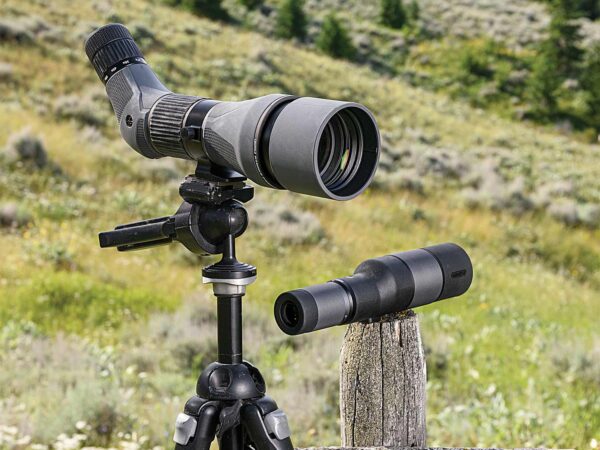If you have interest in astronomy, a spotting scope is a handy item to have. Spotting scopes offer higher magnification which makes them ideal for viewing celestial objects. The best spotting scopes for astronomy are much simpler to use, versatile and a better alternative to telescopes as they are easier to hold and keep stable.
However, there are so many spotting scopes out there that it becomes a little overwhelming to find the best model for astronomy. If you have been searching for the best spotting scopes for astronomy to no avail, we are here to help. We have a roundup of the best spotting scopes for astronomy available on the market today.
These sighting tools will give you better views of different celestial objects whether you are viewing them at home or while on the go. Let’s take a look.
Our Best Spotting Scopes for Astronomy at a Glance
- Celestron C5 Spotting Scope, 52292
- Celestron 52268 C90 Mak Spotting Scope
- Vortex Optics Razor HD Spotting Scopes
- Orion 80mm ED Semi-Apo Binocular Spotting Scope
- Celestron 52238 C70 Mini Mak Spotting Scope, 25-75x
- Visionking 25-75×70 Maksutov Spotting Scope
- Celestron – Ultima 100 Angled Spotting Scope
Best Spotting Scopes for Astronomy
1) Celestron C5 Spotting Scope, 52292, Black
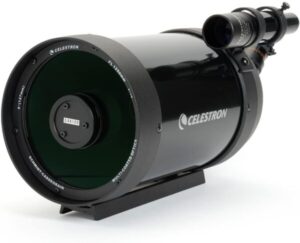
The Celestron C5 Spotting Scope is the best spotting scopes for astronomy out there. It is equipped with virtually every feature that you need for astronomy. It has a user-friendly design that makes it simple to use for all astronomers, beginners and professionals alike.
Featuring a high 50x magnification and a large 5” aperture, the scope is up to the task. The large aperture design provides a wide-field of view and high light gathering ability for bright, detailed views. Better yet, the scope accepts a large variety of 1.25” mount eyepieces for more magnification. It also lightweight and compact in size for easy portability.
Moreover, the spotting scope features Celestron’s proprietary StarBright XLT optical coatings which maximize light transmission for bright image production. It also comes with a 6x30mm erect image finder scope which helps you locate the celestial objects before you observe them on the large objective lens. And that’s not all. This top-performing spotting scope mounts easily on any camera tripod and has an angled eyepiece design which makes it ideal for Digiscoping. Overall, it is an excellent spotting scope for birding and nature observation, not just astronomy.
Features
- Lightweight and portable
- 5” Schmidt-Cassegrain optical design
- 45-degree erect image diagonal
- 6x30mm erect image finder scope
- StarBright XLT optical coatings
- Compatible with 1.25” eyepieces
- Numerous accessories included
- Versatile mounting options
- Large 5-inch aperture
- Waterproof construction
2) Celestron 52268 C90 Mak Spotting Scope
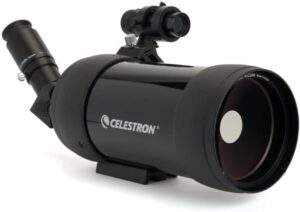
If you are looking for the best spotting scope for astronomy for the money, look no further than the Celestron C90 Mak Spotting Scope. It offers a wide array of features at a remarkably affordable price. Besides, it is an all-round spotting scope which is ideal for both astronomical and terrestrial use.
The spotting scope features the renowned Maksutov-Cassegrain optical design which provides high power views free of chromatic aberration. The optics also feature excellent multi-coatings which maximize light transmission for bright and crisp image production.
Another strength about the scope is that it features a large 90mm objective lens which provides a wide viewing angle for easy object identification. It comes with an 8x21mm erect image finder scope and it is compatible with any 1.25-inch eyepieces. With the 1.25-inch eyepiece, the scope yields a high magnification of up to 100x which you can use to look at Jupiter, stars, moon and other celestial objects clearly.
To top it all, this optic comes with built-in T adapter threads for easy mounting of SLR cameras and a compact, lightweight design for easy portability.
Features
- 8x21mm erect image finder scope
- Built-in T adapter threads
- Erect image system
- Multi-coated optics
- Maksutov-Cassegrain optical design
- Compact and portable
- Compatible with any 1.25” eyepieces
- Excellent high-power optics
- Durable backpack case included
3) Vortex Optics Razor HD Spotting Scopes
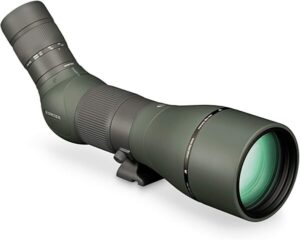
Vortex is a leading and respected brand in the industry of optics. It makes premium-quality optics and the Razor HD 27-60×85 angled spotting scope is not any different. The scope is made with high-end optical technologies which make it one of the finest spotting scopes out there.
Featuring a large 85mm aperture and fully multi-coated lenses, the scope provides bright and tack-sharp sight pictures in every light settings. Also included are advanced optical elements which remove all aberrations for distortion-free images with superior edge-to-edge clarity, resolution and color fidelity.
Another thing that makes the spotting scope stand out is the durable housing. It is made with high-quality materials so you will get many years from it. Additionally, it has a rubber armor which cushions it from shock and impacts, and an Armortek coating which protects the external lenses from oil, dirt and scratches.
Furthermore, the scope is sealed with O-rings and argon purged so it is waterproof and fog proof. For added convenience, it has a smooth helical focus for easy image focusing and a multi-position eyecup which twists up to provide a long eye relief. To top it all, the spotting scope has a manageable weight for easy portability.
Features
- Waterproof and fog proof
- Multi-position eyecup
- Smooth helical focus
- Armortek lens coating
- Multi-layer prism coating
- High-density extra-low dispersion glass
- Triplet Apochromatic lens
- Long eye relief
- Flexible viewing angle
4) Orion 80mm ED Semi-Apo Binocular Spotting Scope

Another best spotting scope for astronomy on our list is the Orion 80mm ED Semi-Apo Binocular Spotting Scope. It features a large 80mm objective doublet lens for optimal light collection and bright image production. It is also made with premium optical glass which attenuates chromatic aberration to generate clear and sharp as razor sight pictures.
The spotting scope is virtually unbreakable. It is built with high-quality materials for ultimate durability. It is waterproof for use in any weather conditions and impact resistant for greater durability. Furthermore, it comes with a built-in mounting bracket with 1/4”-20 threaded holes for easy attachment on a tripod.
Another good thing about the spotting scope is the built-in binocular viewing design. It is rotatable for comfortable glassing. It also reduces eye strain during long glassing sessions and it provides excellent 3D-like depth of field. To add on that, the scope comes with a 360-degree rotation collar which helps you orient the eyepieces to an angle that is most comfortable for you.
Features
- Built-in mounting bracket
- 360-degree rotation collar
- Waterproof construction
- Extra-low dispersion glass
- Long eye relief
- Integrated binocular viewer
- Dielectric coated, beam-splitting mirror
- Large 80mm aperture
- Durable construction
- 500mm focal length
5) Celestron 52238 C70 Mini Mak Spotting Scope, 25-75x
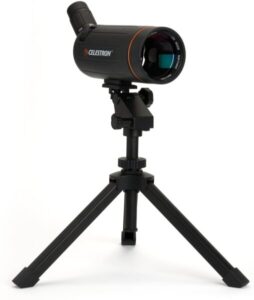
Next on our list is the C70 Mini Mak Spotting Scope from Celestron. It features a wide 25x to 75x magnification which powerful enough bring the celestial objects closer. The scope also accepts a wide range of 1.25” eyepieces to provide the much-needed high magnification. Weighing about 3.21 ounces, this spotting scope is the lightest on our list. In addition to being lightweight, it is compact in size for easy portability and ease of use.
In terms of the optical features, it comes with a Maksutov-Cassegrain optical design which provides high-quality image views free of chromatic aberration. Furthermore, the spotting scope provides a large field of view which is essential for easy location of different celestial objects. The optics are multi-coated to maximize light transmission particularly in low light settings and reduce light loss through reflection. To top it all, the scope is highly versatile and ideal for both terrestrial and celestial application.
Features
- Maksutov-Cassegrain optical design
- Wide 25-75x magnification
- Multi-coated optics
- Compact in size and lightweight
- Easy to use
- Portable and highly versatile
- Compatible with a wide range of 1.25” eyepieces
- Tabletop tripod and view-through case included
6) Visionking 25-75×70 Maksutov Spotting Scope
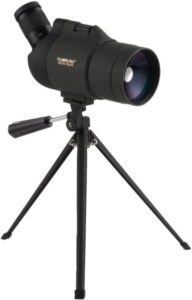
The Visionking 25-75×70 Maksutov Spotting Scope is one of the best spotting scopes for astronomy for beginners. It brings to the table an array of high-end and pleasant features at a cost-effective price. It is also very simple to operate.
Featuring a large 25x to 75x magnification, the scope provides enough power to help you see celestial objects clearly. It has a large 70mm objective lens for superior image brightness and high-quality BaK-4 prism that offers brilliant, clear and sharp as razor images. Moreover, it has fully multi-coated glass lenses which deliver unmatched image brightness and resolution.
Another noteworthy feature about the spotting scope is the all-weather construction. It is nitrogen filled and sealed with strong O-rings to provide reliable waterproof and fog proof performance. It also brings to the table a long eye relief which provides a comfortable glassing experience for all users, with or without eyeglasses. In addition to everything else, the scope has a lightweight, ergonomic design for comfortable carrying.
Features
- Waterproof and fog proof
- Fully multi-coated optics
- Long eye relief
- Lightweight, ergonomic design
- Large 25x-75x magnification
- Premium BaK-4 prisms
- Large 70mm objective lens
7) Celestron – Ultima 100 Angled Spotting Scope
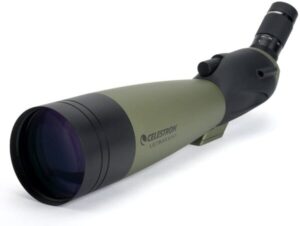
When it comes to versatility, it is hard to beat the Ultima 100 Angled Spotting Scope from Celestron. This is an all-round scope suitable for terrestrial and celestial usage. It has a user-friendly design and a super snug 45-degree viewing angle which reduces neck and eye strain during lengthy glassing sessions.
Featuring a large 100mm aperture, the scope provides a wide field of view and optimal light gathering abilities. Every lens surface is coated several times with anti-reflective coatings to increase light transmission for bright and sharp image generation. Moreover, the scope comes with a built-in T-adapter for Digiscoping and an extended tripod mounting plate for comfortable viewing.
This angled spotting scope is built ready for use in any weather condition. It is waterproof and fog resistant for reliable all-weather performance. It comes with a rugged, armored exterior which provides reliable protection against rough outdoor handling. It also features a sharp zoom eyepiece which helps you zero in for detailed views of distant subjects.
Features
- Large focus dials
- Fully waterproof and fog proof
- Rugged armored exterior
- Multi-coated optics
- Sharp zoom eyepiece with built-in T-adapter
- Large 100mm objective lens
- 45-degree viewing angle
- Portable and durable refractor design
See Also
Criteria for choosing the Best Spotting Scopes for Astronomy
Whether you are buying your first spotting scope for astronomy or looking for an upgrade, here are the key things you should look out for that will help you make the right buying decision.
Optical Design
Spotting scopes for astronomy have either refractor tubes or catadioptric tubes. The former has lenses inside while the latter has both mirrors and lenses inside.
The mirrors inside catadioptric tubes allow the focal length to be longer while the tube remains shorter in length and lightweight. Most spotting scopes for astronomy are catadioptric while most regular spotting scopes are refractors.
Magnification
Magnification is another important factor to consider. Magnification helps bring the distant celestial objects closer to your eyes. With spotting scopes for astronomy, high magnification power will provide clearer views of the distant objects. As you look for a spotting scope with high magnification, also make sure that it has a large aperture to complement the high magnification.
Aperture (Objective Lens Diameter)
For astronomy, it is best to get a spotting scope with a large aperture. The larger the objective lens, the more light is collected. This results to production of brighter and better image views. Furthermore, a large aperture provides a wide field of view which is essential for easy object location.
Eye Relief
Eye relief refers to the maximum distance between your eye and the eyepiece of the spotting scope. If it is too short, then you will have a hard time viewing your objects comfortably especially if you wear eyeglasses. So, make sure that you get a model that has a long eye relief to ensure comfortable glassing.
Weight
The other important factor to consider when choosing the best spotting scopes for astronomy is weight. If you intend to watch the stars, moon and other celestial objects while on the go, it is best to get a spotting scope that has a lightweight design. This way, you will have a comfortable time carrying it around. If your plan is to use the spotting scope to look at the different celestial objects at the comfort of your home, you don’t need to worry much about the weight.
Angled Vs Straight Spotting Scopes for Astronomy
Spotting scopes are available in two eyepiece designs: straight and angled. For astronomy, it is best to get a model that has an angled eyepiece design. It will be more comfortable to glass during long viewing sessions as it minimizes eye and neck strain.
Additionally, angled spotting scopes are more convenient to use for Digiscoping. You can attach a camera or smartphone and take pictures of the celestial objects that you observe. Angled spotting scopes are also more suitable for group sharing.
Advantages of Spotting Scopes for Astronomy
- Spotting scopes are more compact for easy portability and lightweight for easy handling.
- versatility. You can get a spotting scope that is ideal for astronomy as well as other outdoor applications like birding, wildlife viewing, tactical shooting and more.
- Dual functionality. You can use a spotting scope for astronomy at night and for viewing terrestrial objects during the day.
- Great durability. Since spotting scopes are made to be handy, they are more durable than telescopes for astronomy.
- Ease of use. Spotting scopes are easier to use than telescopes. They don’t require any set up process.
FAQs
- Are spotting scopes good for astronomy?
Absolutely. Spotting scopes are valuable tools for astronomy. They offer excellent versatility and great optical performance for most basic astronomy. They are more durable, more portable and easy to use.
- Can you use a spotting scope for astrophotography?
Yes. You can attach a camera or a smartphone on your spotting scope for astronomy and take pictures of the celestial objects that you observe.
- Can you see the moon with a spotting scope?
Yes. A spotting scope with a wide magnification of at least 60x and a large aperture will let you see the moon clearly. You will also be able to see the stars, planets and other celestial objects clearly if you have a good-quality spotting scope.
Final Thoughts
In conclusion, finding the best spotting scope for astronomy doesn’t have to be a daunting and time-consuming experience. With the market offering a wide array of models to choose from, focus on getting a spotting scope will work best for your needs. It should durable, functional and versatile . Invest in any spotting scope on our list above and watch it give you galactic views you have never seen before.

